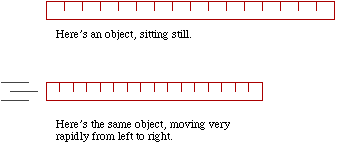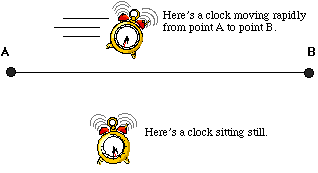
In fact, both of these things are true. The first effect we call "length contraction" while we call the second effect "time dilation".
The length of an object in a frame in which it is moving is shorter than the length of the same object in a frame in which it's at rest.An illustration may make this less confusing:

This contraction is not an illusion. Any accurate experiment we might devise to measure the length of this ruler as it moves past us will reveal a shorter length than the object has at rest. The ruler doesn't just look shorter when it's moving. It is shorter! However, it's only shorter along the direction it's moving. In the second illustration above, the ruler is moving horizontally, and it's shortened horizontally. You might notice that vertically, it's the same size in both illustrations.
The time between two events, in a frame in which those events occur at different locations, is longer than the time between those same two events, in a frame in which those events occur at the same location.This one's a bit more confusing. Again, I'll try to illustrate.

A simpler, less precise way of stating this principle is:
A moving clock runs more slowly than a stationary clock.The most famous hypothetical illustration of time dilation is usually called the twin paradox. Suppose there are twins named Harry and Mary. Mary takes off in a spaceship which travels very fast away from earth (it must travel close to the speed of light for the effect to be noticeable) and returns very fast. We can think of the human body as a clock which records the passage of time by aging. Since Mary is moving very fast, her clock runs slowly, compared to Harry's clock. As a result, when Mary arrives back at earth she has aged less than Harry has. How much less depends on how far she has traveled, and how fast.
Time dilation is not just a crazy idea. It has been verified experimentally. Perhaps the best example of this involves a subatomic particle called a muon. The muon is an unstable particle, which means that shortly after one is created, it decays into lighter particles. How long a muon takes to decay has been measured very precisely. Anyway, it's been observed that a muon moving close to the speed of light lives longer than a muon that's at rest or moving slowly. This is a relativistic effect. From the point of view of the moving muon it doesn't live any longer, because from its point of view, it's at rest. It's only in the frame of the laboratory through which the muon moves that the lifetime is lengthened, or "dilated".
I should add at this point that there are many, many other tests of the ideas we've seen so far, and of the other implications of relativity that we'll see later. My point is, even though it's still often referred to as the "theory" of relativity, don't think that this implies that special relativity is in doubt. It's very well established.